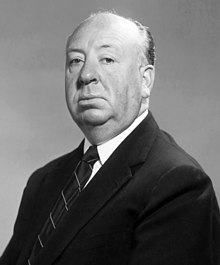 |
| Alfred Hitchcock, courtesy of wikimedia.org |

#50. The Changeling (1980)
Our countdown starts with one of the best haunted house horror films ever produced. Starring George C. Scott (not Angelina Jolie), The Changeling focuses on a writer whose wife and daughter die in a horrific car accident. As he suffers through his depression and despair, he is encouraged to rent a historic mansion, so he may be alone with his thoughts to write. Unfortunately, he finds that he is not alone in this house, and the ghost of a young murdered child wants to use him to find answers of its own. Director Peter Medak had mostly done TV work, but here he unleashed a standard in haunted house films, where the horror is in what is happening off-screen, as opposed to slapping the audience in the face.

#49. Cat People (1942)
An early indication of how much scarier films can be if you don't see the horror, Jacques Tourneur's Cat People is the story of Serbian immigrant Irena (Simone Simon), as she marries an average American man (Kent Smith) after she comes to the country. Their marriage starts to fall apart, as Irena begins to suspect she suffers from an ancient curse which, when she is emotionally disturbed, will force her to shape shift in to a panther-like creature and attack. Her husband laughs it off and enlists a psychiatrist to help her, but the results are not as simple as that. Tourneur uses light and sound effects to amp up the tension in this simple, but brilliant early example of audience creating the fear in their own minds.

#48. The Descent (2005)

#47. Dead Ringers (1988)
You don't see many actors receiving Oscars as an apology for ignoring their work in a horror film very often. But, it happened to Jeremy Irons, who won the Oscar for Reversal of Fortune in 1990, prompting him to thank director David Cronenberg for his work on this film. Cronenberg is a master of psychological horror (he's on this list a few more times) and Dead Ringers may be his grand masterpiece in the genre, a twisted story of twin gynecologists - one more confident and mentally superior to the other - who "share" women. That is, until the lesser of the twins falls in love with an actress (also a patient), forcing them to take on each other and the psychological games that have been played for years. Irons is magnificent in both roles and Cronenberg dials up the terror that affects much deeper than the surface scares of most horror films.

#46. Re-Animator (1985)
A severed head. Anybody familiar with the film knows where the iconic scene goes from there. Stuart Gordon's feature film debut centers on a medical student (Jeffrey Combs) and his girlfriend (Barbara Crampton), and their participation in some twisted experiments as a new, somewhat strange students comes to town. Based on an H.P. Lovecraft story, Gordon allows the film to begin as a somewhat farcical, comedic story, but eventually devolves into a all out gore fest. As the students begin working to re-animate dead flesh and cadavers, the story goes out the window and ridiculousness ensues, most notably involving the severed head I mentioned earlier. In a decade of crazy concepts and silly ideas, Re-Animator may take the cake for sheer imagination and insanity.

#45. Paranormal Activity (2007)

#44. The Brood (1979)

#43. Misery (1990)
And the Oscar goes to...Kathy Bates for this Rob Reiner adaptation of one of Stephen King's best horror novels. Misery centers around author Paul Sheldon (James Caan), as he gets stranded in a snow storm, only to be rescued y a fan named Annie (Bates), taking him to her secluded cabin. Sheldon has recently decided to kill off one of his most popular characters from his series of novels and this doesn't sit well with Annie. So, instead of mending Sheldon and sending him on his way, Annie decides to hold the author hostage and force him to write a new novel, starring her favorite character. The suspense is seething, Bates is magnificent and terrifying, and the claustrophobia Reiner creates is spine tingling. Your ankles will never feel the same again.

#42. Cannibal Holocaust (1980)
Long before the found footage I mention above became the norm, Italian director Ruggero Deodato released Cannibal Holocaust, spreading the rumor that the footage was found after a camera crew went to film a documentary about lost cannibal tribes in the Amazon. Though completely fictional, the guise he created, paired with the grotesque imagery was stomach-turning, even in a time when social media didn't spread gossip like wildfire. It would eventually be equaled and surpassed in terms of bloody imagery, it was one of the first films that depended heavily on what viewers saw on screen, which was truly unsettling. It eventually amounts to nothing more than a snuff film, but Deodato's ingenious idea led to plenty of imitators, some good, most bad.
#41. Repulsion (1965)
Roman Polanski's first English language film is probably his most visceral, relying on his lead actress to shoot the tension to other worldly levels. Repulsion stars Catherine Deneuve as Carol, a beautiful, virginal manicurist who lives with her sister. She hates her sister's lover - a married man - which helps build her objection to sexuality, though she has a dedicated boyfriend. When her sister leaves for a holiday with her lover, Carol begins to unravel, locking herself in the apartment, refusing to exit. She has seemingly schizophrenic hallucinations and we watch her mind deteriorate, as she begins to turn on people she loves and aggressively acts out as a result. A terrifying look at a mind's breakdown, Polanski's first foray into English is an unforgettable one.



No comments:
Post a Comment